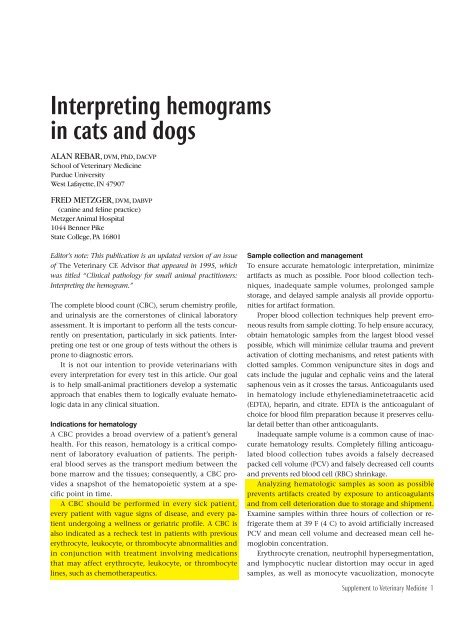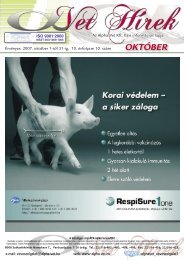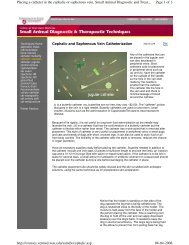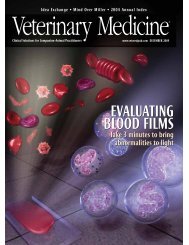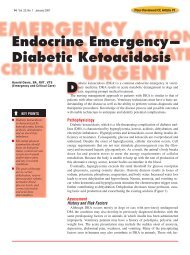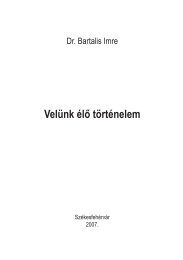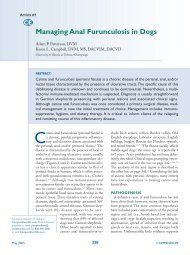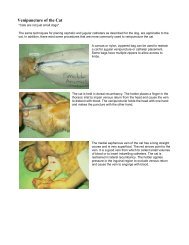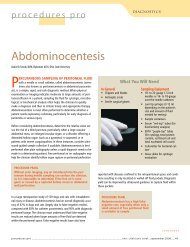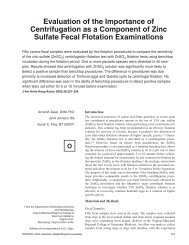CEA Idexx hemo-2001.12v9 - Hungarovet
CEA Idexx hemo-2001.12v9 - Hungarovet
CEA Idexx hemo-2001.12v9 - Hungarovet
- No tags were found...
You also want an ePaper? Increase the reach of your titles
YUMPU automatically turns print PDFs into web optimized ePapers that Google loves.
Interpreting <strong>hemo</strong>grams<br />
in cats and dogs<br />
ALAN REBAR, DVM, PhD, DACVP<br />
School of Veterinary Medicine<br />
Purdue University<br />
West Lafayette,IN 47907<br />
FRED METZGER, DVM, DABVP<br />
(canine and feline practice)<br />
Metzger Animal Hospital<br />
1044 Benner Pike<br />
State College,PA 16801<br />
Editor’s note: This publication is an updated version of an issue<br />
of The Veterinary CE Advisor that appeared in 1995, which<br />
was titled “Clinical pathology for small animal practitioners:<br />
Interpreting the <strong>hemo</strong>gram.”<br />
The complete blood count (CBC), serum chemistry profile,<br />
and urinalysis are the cornerstones of clinical laboratory<br />
assessment. It is important to perform all the tests concurrently<br />
on presentation, particularly in sick patients. Interpreting<br />
one test or one group of tests without the others is<br />
prone to diagnostic errors.<br />
It is not our intention to provide veterinarians with<br />
every interpretation for every test in this article. Our goal<br />
is to help small-animal practitioners develop a systematic<br />
approach that enables them to logically evaluate hematologic<br />
data in any clinical situation.<br />
Indications for hematology<br />
A CBC provides a broad overview of a patient’s general<br />
health. For this reason, hematology is a critical component<br />
of laboratory evaluation of patients. The peripheral<br />
blood serves as the transport medium between the<br />
bone marrow and the tissues; consequently, a CBC provides<br />
a snapshot of the hematopoietic system at a specific<br />
point in time.<br />
A CBC should be performed in every sick patient,<br />
every patient with vague signs of disease, and every patient<br />
undergoing a wellness or geriatric profile. A CBC is<br />
also indicated as a recheck test in patients with previous<br />
erythrocyte, leukocyte, or thrombocyte abnormalities and<br />
in conjunction with treatment involving medications<br />
that may affect erythrocyte, leukocyte, or thrombocyte<br />
lines, such as c<strong>hemo</strong>therapeutics.<br />
Sample collection and management<br />
To ensure accurate hematologic interpretation, minimize<br />
artifacts as much as possible. Poor blood collection techniques,<br />
inadequate sample volumes, prolonged sample<br />
storage, and delayed sample analysis all provide opportunities<br />
for artifact formation.<br />
Proper blood collection techniques help prevent erroneous<br />
results from sample clotting. To help ensure accuracy,<br />
obtain hematologic samples from the largest blood vessel<br />
possible, which will minimize cellular trauma and prevent<br />
activation of clotting mechanisms, and retest patients with<br />
clotted samples. Common venipuncture sites in dogs and<br />
cats include the jugular and cephalic veins and the lateral<br />
saphenous vein as it crosses the tarsus. Anticoagulants used<br />
in hematology include ethylenediaminetetraacetic acid<br />
(EDTA), heparin, and citrate. EDTA is the anticoagulant of<br />
choice for blood film preparation because it preserves cellular<br />
detail better than other anticoagulants.<br />
Inadequate sample volume is a common cause of inaccurate<br />
hematology results. Completely filling anticoagulated<br />
blood collection tubes avoids a falsely decreased<br />
packed cell volume (PCV) and falsely decreased cell counts<br />
and prevents red blood cell (RBC) shrinkage.<br />
Analyzing hematologic samples as soon as possible<br />
prevents artifacts created by exposure to anticoagulants<br />
and from cell deterioration due to storage and shipment.<br />
Examine samples within three hours of collection or refrigerate<br />
them at 39 F (4 C) to avoid artificially increased<br />
PCV and mean cell volume and decreased mean cell <strong>hemo</strong>globin<br />
concentration.<br />
Erythrocyte crenation, neutrophil hypersegmentation,<br />
and lymphocytic nuclear distortion may occur in aged<br />
samples, as well as monocyte vacuolization, monocyte<br />
Supplement to Veterinary Medicine 1
pseudopod formation, and platelet aggregation. To prevent<br />
these morphological artifacts from occurring, prepare<br />
blood films within one hour of collection. In addition,<br />
keep formalin and formalin-containing containers<br />
away from all blood and cytologic smears to prevent inadequate<br />
staining.<br />
Blood film preparation and examination<br />
Examining blood films provides vital information for<br />
practitioners. Proper preparation and staining and systematic<br />
examination are necessary to interpret blood<br />
films accurately.<br />
Producing high-quality blood films begins with clean,<br />
new slides; used slides frequently contain scratches and<br />
other physical imperfections. Slides must be free of fingerprints,<br />
dust, alcohol, detergents, and debris. Using a microhematocrit<br />
tube, place a small drop (2 to 3 mm in diameter)<br />
of well-mixed EDTA blood approximately 1 to 1.5 cm<br />
from the end of the sample slide. Next, draw a spreader<br />
slide back into the blood drop at approximately a 30-degree<br />
angle until the spreader slide’s edge touches the sample<br />
drop and capillary action disperses the sample along<br />
the edge. Then use a smooth and steady motion to push<br />
the spreader slide away from the blood drop, creating a<br />
uniform film that covers nearly the entire length of the<br />
slide. Note that changing the angle of the spreader slide<br />
will change the length and thickness of the blood film.<br />
Allow the blood film to air-dry thoroughly before staining,<br />
and do not heat it. A high-quality blood film should have<br />
three distinct zones: the thick layer, the monolayer, and<br />
the feathered edge.<br />
Most veterinary practices use Diff-Quik (Dade Behring)<br />
stain, which is a modified Wright’s stain. Diff-Quik stain<br />
uses three separate solutions: an alcohol fixative (light blue<br />
in color), an eosinophilic staining solution (orange), and<br />
methylene blue stain (dark blue). To help ensure reliable<br />
results, use two separate Coplin stain jar sets—one for<br />
staining hematologic and cytologic samples and one for<br />
staining contaminated samples, such as ear and fecal cytologic<br />
specimens. Replace Diff-Quik stains routinely for optimal<br />
results. To properly stain the sample, dip the airdried<br />
slide five to 10 times in each solution while blotting<br />
one edge briefly in between each solution. Rinse the slide<br />
with distilled water after the final staining step with the<br />
methylene blue, and allow the stained blood film to airdry<br />
before examination.<br />
A high-quality microscope is essential for hematology<br />
and cytology. We recommend a binocular microscope with<br />
10, 20, 50 or 60, and 100 oil immersion objectives.<br />
The microscope manufacturer will include cleaning<br />
instructions and maintenance information.<br />
Systematic blood film evaluation includes assessment of<br />
all three zones of the film. In the monolayer—the zone between<br />
the thick layer where the blood drop originated and<br />
the much thinner feathered edge—the cells are individualized<br />
and do not overlap. This monolayer is the only area<br />
where evaluation of cell morphology should take place.<br />
First, examine the blood film at low magnification<br />
(10 or 20) and scan the entire slide to determine overall<br />
film thickness, cell distribution, and differentiation of<br />
the three layers. Examine the feathered edge for the presence<br />
of microfilariae, phagocytosed organisms, atypical<br />
cells, and platelet aggregation. Then, still using low magnification,<br />
evaluate the monolayer. Estimate the total<br />
white blood cell (WBC) count (see below) and predict the<br />
expected WBC differential count. Finally, use oil immersion<br />
(100) to examine erythrocyte, leukocyte, and<br />
platelet morphology. Evaluate RBCs for evidence of anisocytosis,<br />
poikilocytosis, polychromasia, <strong>hemo</strong>globin concentration,<br />
and RBC parasites. Important erythrocyte<br />
morphologic abnormalities include spherocytes, schistocytes,<br />
acanthocytes, and burr cells, among others. Examine<br />
leukocytes for important information—neutrophils<br />
for toxic change and the presence or absence of a left shift<br />
(elevated band neutrophils), lymphocytes for reactivity,<br />
and monocytes for phagocytosed organisms.<br />
Determination of cell counts<br />
Several technologies have been applied to determine erythrocyte,<br />
leukocyte, and thrombocyte counts in veterinary<br />
medicine. Traditional in-clinic hematologic evaluation<br />
methods include estimations from blood films, manual<br />
counting, electronic resistance (impedance) counters, and<br />
quantitative buffy coat analysis. Most reference laboratories<br />
use impedance technology or laser flow cytometry.<br />
Making accurate cell count estimations directly from<br />
blood films requires experience. One method of estimating<br />
total leukocyte counts involves counting several 20 objective<br />
fields—10 to 20 WBCs per 20 field is considered normal<br />
in dogs and cats. Another method is to count several<br />
100 oil immersion fields, then multiply the average number<br />
of WBCs per 100 oil immersion field by 2,000 to obtain<br />
a final estimated total WBC count. Determining total<br />
erythrocyte numbers from blood films is not recommended<br />
because variations in film thickness make counts imprecise.<br />
Manual cell counting requires a counting chamber<br />
(hemacytometer) and close visual inspection. Although<br />
this method is inexpensive, it is labor-intensive and requires<br />
operator training and experience for successful<br />
analysis. Studies report a margin of error of 20% to 25%<br />
compared with automated methods. 1<br />
Electronic (impedance) counters use the Coulter principle<br />
developed in 1945. In this system, a suspension of<br />
blood cells in a metered volume of electrolyte medium<br />
2 December 2001
TABLE 1<br />
General patterns of leukocyte response<br />
Total WBC Segmented Band<br />
Inflammation<br />
Acute<br />
count<br />
Increased<br />
neutrophils<br />
Increased<br />
neutrophils<br />
Increased<br />
Lymphocytes<br />
Decreased or<br />
Monocytes<br />
Variable<br />
Eosinophils<br />
Variable<br />
no change<br />
Chronic Increased or Increased or Increased or Increased or Increased Variable<br />
no change no change no change no change<br />
Overwhelming Decreased Decreased or Increased Decreased or Variable Variable<br />
no change<br />
no change<br />
Excitement Increased Increased in dogs; No change No change in No change No change<br />
leukocytosis increased or no dogs; increased<br />
change in cats<br />
in cats<br />
Stress leukogram Increased Increased No change Decreased Increased or Decreased<br />
no change<br />
flows through a small orifice where a constant electrical current<br />
is applied. In theory, each cell emits an electrical signal<br />
unique to its classification, which the device registers and<br />
records. Disadvantages of impedance technology include a<br />
great deal of analyzer maintenance and cleaning, grouping<br />
of granulocytes together, and an inability to provide valuable<br />
reticulocyte information. In addition, platelet clumping<br />
frequently results in an artifactually increased total<br />
WBC count and decreased platelet counts because impedance<br />
counters often register clumped platelets as leukocytes.<br />
Quantitative buffy coat technology incorporates cellular<br />
density and nuclear and cytoplasmic staining characteristics<br />
to discriminate cellular types. Advantages of this<br />
technique include ease of use, low maintenance, system<br />
abnormality alerts, a reticulocyte percentage report, and a<br />
visual buffy coat graph to aid in interpretation. Disadvantages<br />
include the inability to recognize feline eosinophils<br />
and the grouping of lymphocytes and monocytes together.<br />
Furthermore, the operator must understand the buffy coat<br />
graph to maximize the system’s usefulness.<br />
Laser flow cytometry uses optical laser scattering to distinguish<br />
cellular elements. Advantages of this technology<br />
include a full five-part WBC differential (neutrophils,<br />
eosinophils, basophils, lymphocytes, and monocytes) plus<br />
expanded RBC information (reticulocyte percentage and<br />
absolute reticulocyte count) and platelet data (platelet volume<br />
and count). The disadvantage is the higher cost associated<br />
with this more sophisticated technology.<br />
Hemogram interpretation<br />
A CBC is composed of WBC, RBC, and platelet data as well<br />
as total protein concentration. In general, we prefer to<br />
evaluate WBC data first, RBC and protein data collectively<br />
next, and platelet data last. This order is useful because<br />
changes in WBCs often predict alterations in other <strong>hemo</strong>gram<br />
findings.<br />
Evaluating the WBCs (leukogram)<br />
Leukogram data include total and differential WBC<br />
counts and a description of WBC morphology from the<br />
peripheral blood film. Differential cell counts should always<br />
be expressed and interpreted in absolute numbers,<br />
not percentages. All leukocyte compartments—including<br />
neutrophils and their precursors, eosinophils, basophils,<br />
monocytes, and lymphocytes—must be counted.<br />
WBC data are used to answer the following questions:<br />
1. Is there evidence of inflammation<br />
2. Is there evidence of a glucocorticoid (stress) or epinephrine<br />
(excitement) response<br />
3. Is there a demand for phagocytosis or evidence of tissue<br />
necrosis<br />
4. If inflammation is present, can it be further classified<br />
as acute, chronic, or overwhelming<br />
5. Is there evidence of systemic toxemia<br />
Table 1 lists the general patterns of leukocyte response<br />
under a variety of circumstances.<br />
1. Is there evidence of inflammation Neutrophilic left<br />
shifts (Figure 1), persistent eosinophilia, and monocytosis<br />
(Figure 2) are the best indicators of inflammation. Left<br />
shifts (increased numbers of immature, or band, neutrophils<br />
in circulation) indicate increased turnover and tissue<br />
use of neutrophils. Persistent peripheral eosinophilia<br />
indicates a systemic allergic or hypersensitivity reaction.<br />
Monocytosis is seen in peripheral blood when there is a<br />
demand for phagocytosis.<br />
Supplement to Veterinary Medicine 3
1. Blood film from a dog with<br />
inflammation (Wright’s stain;<br />
100). Leukocytosis, neutrophilia,<br />
and a left shift were<br />
evident on the CBC.<br />
2. Blood film from a dog<br />
with an inflammatory leukogram<br />
with monocytosis (Wright’s<br />
stain; 100). Three monocytes<br />
and a neutrophil are visible.<br />
3. Blood film from a dog with<br />
hemangiosarcoma (Wright’s<br />
stain; 100). An RBC fragment<br />
(schistocyte) is seen in the center.<br />
4. This cat had an inflammatory<br />
leukogram with a left shift<br />
(Wright’s stain; 100). The band<br />
cell at the left is toxic, with<br />
basophilic granular cytoplasm.<br />
Figure 1 Figure 2<br />
Figure 3<br />
Figure 4<br />
Inflammatory leukograms without any of the above<br />
changes are possible, but they are harder to recognize. For<br />
example, a mild leukocytosis with mature neutrophilia<br />
may indicate inflammation, but it may also represent a<br />
physiological response to an epinephrine surge (excitement<br />
leukocytosis) or a response to endogenous or exogenous<br />
glucocorticoids. When the results of a leukogram are<br />
ambiguous, they can sometimes be clarified by repeating<br />
the CBC after several hours or days or testing for other<br />
markers of inflammation, such as erythrocyte sedimentation<br />
rates, fibrinogen concentrations, or reactive C-protein<br />
concentrations. A period of four hours is generally required<br />
to see important changes in the leukogram.<br />
2. Is there evidence of a glucocorticoid (stress) or epinephrine<br />
(excitement) response High concentrations of<br />
circulating glucocorticoids cause a mild mature neutrophilia,<br />
lymphopenia and eosinopenia, and mild monocytosis.<br />
Of these changes, lymphopenia is the most consistent<br />
and reliable indicator of stress. We regard lymphocyte<br />
counts of 1,000 to 1,500/µl as marginal lymphopenia,<br />
whereas lymphocyte counts below 1,000/µl are absolute<br />
lymphopenias. Stress typically results in lymphopenias in<br />
the range of 750 to 1,500 lymphocytes/µl. When lymphocyte<br />
counts drop below 600/µl, we consider other causes<br />
of lymphopenia, such as chylous effusions, lymphangiectasia,<br />
and malignant lymphoma.<br />
The presence or absence of a glucocorticoid response in<br />
the leukogram carries important implications for the interpretation<br />
of other laboratory data. High concentrations of<br />
circulating glucocorticoids can be associated with mild to<br />
moderate hyperglycemia in dogs (elevations that do not<br />
exceed the renal threshold), marked hyperglycemia in<br />
cats, and elevations in serum alanine transaminase (ALT)<br />
and serum alkaline phosphatase (ALP) activities in dogs. In<br />
particular, stress lymphopenias can be important in interpreting<br />
hepatic disorders. As a guideline, a greater than<br />
fourfold rise in serum ALP activity in a dog results either<br />
from cholestasis or high concentrations of circulating glucocorticoids.<br />
If lymphopenia is present, neither cause can<br />
be eliminated; if lymphopenia is absent, cholestatic liver<br />
disease is likely.<br />
It’s important to distinguish the stress response accompanied<br />
by an increased concentration of circulating glucocorticoids<br />
from the excitement response associated with<br />
increased concentrations of epinephrine. The stress response<br />
is the result of changes both in circulating and<br />
bone marrow pools of leukocytes; it takes several hours to<br />
develop and persists for about 24 hours.<br />
In contrast, with the excitement response, increased<br />
blood flow mobilizes marginating leukocytes<br />
from vessel walls and brings them back into circulation.<br />
This type of response dissipates in minutes. In<br />
dogs, excitement leukocytosis is primarily a mild mature<br />
neutrophilia; in cats, it is a lymphocytosis, a neutrophilia,<br />
or both.<br />
3. Is there a demand for phagocytosis or evidence of<br />
tissue necrosis Monocytosis indicates a demand for<br />
phagocytosis or tissue necrosis. Monocytosis is almost<br />
always present in chronic inflammatory conditions, but<br />
it can also occur with acute inflammation. Whenever<br />
you observe a severe monocytosis (> 4,000/µl), prepare a<br />
buffy coat smear to identify any particles or causative<br />
4 December 2001
agents that have been phagocytosed by circulating<br />
monocytes (e.g. opsonized RBCs in immune-mediated<br />
<strong>hemo</strong>lytic anemia, Ehrlichia canis organisms, or Histoplasma<br />
capsulatum organisms).<br />
4. If inflammation is present, can it be further classified<br />
as acute, chronic, or overwhelming In many cases,<br />
the inflammation cannot be further classified based on the<br />
inflammatory leukogram. However, in some cases, the differential<br />
cell count is typical of acute, chronic, or overwhelming<br />
inflammation (Table 1).<br />
The classic acute inflammatory leukogram in dogs and<br />
cats is characterized by neutrophilic leukocytosis with a<br />
left shift (increased numbers of immature neutrophils in<br />
circulation), which is also called a regenerative left shift.<br />
The WBC count is elevated because bone marrow production<br />
and release of granulocytes into the blood is greater<br />
than the migration of granulocytes from the peripheral<br />
blood into the tissues. A left shift is apparent because as<br />
neutrophils are being rapidly mobilized from the bone<br />
marrow, immature neutrophils (band cells) are drawn from<br />
the bone marrow maturation pool into circulation. Generally,<br />
lymphopenia is also present as a reflection of superimposed<br />
stress (glucocorticoid response). The presence of<br />
monocytosis is variable.<br />
In chronic inflammatory conditions, the myeloid marrow<br />
has expanded enough for production to keep pace<br />
with tissue demand, and the left shift dissipates. If the inflammation<br />
is severe and localized, as in the case of a large<br />
abscess or pyometra, then the WBC count may be quite<br />
high, reaching 50,000/µl or more. In most other instances<br />
of chronic inflammation, the total WBC count is closer to<br />
normal. Animals with chronic inflammatory leukograms<br />
usually have normal lymphocyte counts. Monocyte counts<br />
are almost always elevated because of tissue necrosis and<br />
demand for phagocytosis. So a classic chronic inflammatory<br />
leukogram is characterized by a normal to slightly elevated<br />
leukocyte count (rarely dramatically elevated), a normal<br />
to slightly elevated neutrophil count, a normal or elevated<br />
lymphocyte count, and an elevated monocyte count.<br />
Overwhelming inflammatory responses usually occur<br />
with acute conditions in which bone marrow production<br />
is unable to match tissue use. The bone marrow storage<br />
pool of neutrophils is quickly depleted and immature<br />
neutrophils are drawn into circulation, resulting in<br />
leukopenia, normal or decreased neutrophil counts, and a<br />
degenerative left shift. Monocytosis may be present because<br />
of tissue destruction. Superimposed stress lymphopenia<br />
is also common.<br />
Recognizing and classifying inflammatory reactions is<br />
important to the interpretation of other <strong>hemo</strong>gram parameters.<br />
The most common anemia in dogs and cats is the<br />
anemia of inflammatory disease. This is a mild to moderate<br />
nonregenerative anemia, resulting in a PCV as low as<br />
30% in dogs and 25% in cats. This anemia can develop<br />
fairly rapidly (within seven to 10 days), particularly in cats<br />
in which the life span of circulating RBCs is relatively short<br />
(about 80 days). Chronic inflammatory conditions are<br />
often associated with stimulation of the immune system,<br />
hypergammaglobulinemia, and resultant elevated total<br />
protein concentrations. Whenever inflammation is severe,<br />
give special attention to platelet counts. Low platelet numbers<br />
(
Figure 5<br />
Classification of anemia<br />
Decreased PCV<br />
Consider state of hydration<br />
Reticulocyte count—dogs and cats<br />
Regenerative<br />
> 80,000 reticulocytes/µl in dogs<br />
> 60,000 reticulocytes/µl in cats<br />
Nonregenerative<br />
< 80,000 reticulocytes/µl in dogs<br />
< 60,000 reticulocytes/µl in cats<br />
Bone marrow evaluation<br />
Blood loss anemia<br />
Hemolytic anemia<br />
External <strong>hemo</strong>rrhage<br />
Immune-mediated <strong>hemo</strong>lytic anemia with spherocytosis<br />
Internal <strong>hemo</strong>rrhage<br />
Heinz body <strong>hemo</strong>lytic anemia from ingesting onions,<br />
Parasites (fleas, hookworms)<br />
acetaminophen, or other toxins<br />
Takes one to three days to see PCV decrease<br />
Bone marrow hypoplasia<br />
Anemia of inflammation<br />
Anemia of chronic renal disease<br />
Myelophthisis — bone marrow disease<br />
Toxicosis — c<strong>hemo</strong>therapy<br />
Nuclear maturation defect<br />
FeLV infection<br />
Drug toxicosis<br />
Bone marrow hyperplasia<br />
with ineffective erythropoiesis<br />
Cytoplasmic maturation defect<br />
Lead toxicosis<br />
Iron deficiency including chronic<br />
blood loss<br />
Classifying polycythemia. If RBC mass is increased, then<br />
the animal is polycythemic. This then raises the question:<br />
Is the polycythemia relative or absolute Relative polycythemia,<br />
the most common polycythemia recognized in<br />
veterinary medicine, is the result of <strong>hemo</strong>concentration.<br />
Relative polycythemia is generally established based on the<br />
clinical history and signs consistent with dehydration, as<br />
well as an elevated total protein concentration. Polycythemia<br />
in the absence of these findings is absolute. Absolute<br />
polycythemia can be either primary or secondary.<br />
Primary absolute polycythemia, also called polycythemia<br />
vera, is a myeloproliferative disease. It is a multipotential<br />
stem cell defect characterized by overproduction of all cell<br />
lines. The clinical signs—including lethargy, hyperemia,<br />
dyspnea, cardiac murmur, and splenomegaly—are attributed<br />
to hyperviscosity syndrome related primarily to increased<br />
RBC mass. A markedly increased RBC mass (e.g.<br />
PCV = 75%) in the presence of normal arterial oxygen concentrations<br />
and normal or low serum erythropoietin concentrations<br />
generally confirms the diagnosis.<br />
Secondary absolute polycythemia is both appropriate<br />
and compensatory for hypoxemia or inappropriate and<br />
caused by increased concentrations of circulating erythropoietin.<br />
Compensatory polycythemia is present in<br />
animals recently moved to high altitudes or that suffer<br />
from pulmonary or cardiovascular disease. Inappropriate<br />
secondary polycythemia, characterized by excessive erythropoietin<br />
production, often accompanies renal carcinoma,<br />
renal cysts, hydronephrosis, and, occasionally,<br />
nonrenal tumors.<br />
Excessive exogenous administration of erythropoietin<br />
can also cause polycythemia in dogs and cats. Furthermore,<br />
mild polycythemia can result from hyperthyroidism<br />
and hyperadrenocorticism.<br />
Classifying anemias. If RBC mass is reduced, then the<br />
animal is anemic (Figure 5). The degree of anemia should<br />
be further considered in conjunction with plasma protein<br />
concentrations. If protein concentrations are elevated,<br />
then the animal may be dehydrated and the anemia may<br />
be more severe than the RBC mass measures indicate.<br />
Once anemia is recognized, the next issue of concern is<br />
bone marrow responsiveness: Is the anemia regenerative or<br />
nonregenerative If the RBC marrow responds with an increase<br />
in production of the appropriate magnitude, the<br />
anemia is regenerative (responsive). On the other hand,<br />
the anemia is nonregenerative (nonresponsive) when the<br />
increase in RBC production is not sufficient.<br />
6 December 2001
Evidence of RBC regeneration can be evaluated on a peripheral<br />
blood film. In dogs and cats, regeneration is indicated<br />
by the presence of polychromatophils (using Wright’s<br />
or Diff-Quik stain) or reticulocytes (using new methylene<br />
blue stain). These immature RBCs stain bluish because they<br />
contain RNA (Figure 6). Because polychromatophils and<br />
reticulocytes are larger than mature RBCs, another feature<br />
of regeneration is anisocytosis (variation in RBC size). Nucleated<br />
RBCs may also be present in small numbers, but<br />
there should always be fewer of them than polychromatophils.<br />
A large number of nucleated RBCs in the absence<br />
of polychromasia usually indicates bone marrow stromal<br />
damage; this finding is called an inappropriate nucleated<br />
RBC response (Figure 7). This process will be addressed<br />
in more detail in the discussion of lead poisoning anemia.<br />
If the issue of regeneration is still in doubt after you<br />
evaluate stained blood films, do a reticulocyte count. As a<br />
guideline, a reticulocyte count above 60,000/µl in cats<br />
and 80,000/µl in dogs indicates a regenerative anemia. In<br />
many cases, the reticulocyte counts in dogs with regenerative<br />
anemias are much higher than 80,000/µl. Cats show<br />
a somewhat lower overall regenerative capacity than do<br />
dogs. Cats have two types of reticulocytes called aggregate<br />
and punctate. Aggregate reticulocytes indicate active RBC<br />
regeneration, while punctate reticulocytes indicate past<br />
regeneration. When performing a reticulocyte count in a<br />
cat, it is important to count only aggregate reticulocytes.<br />
In both dogs and cats, peak reticulocyte counts occur four<br />
to eight days after the onset of anemia.<br />
Regenerative anemias can be further classified as either<br />
blood loss or <strong>hemo</strong>lytic anemias. Remember that it might<br />
take one to three days for the PCV to decrease from blood<br />
loss because the severity of anemia may be masked by<br />
splenic contraction and restoration of blood volume by<br />
fluid passing from the extravascular space. A patient history<br />
of trauma or parasitic infection may suggest blood loss. Furthermore,<br />
the total protein concentration may be decreased<br />
in such cases. Another useful differentiating factor is that<br />
<strong>hemo</strong>lytic anemias are generally much more regenerative<br />
than are blood loss anemias. Iron is preserved with <strong>hemo</strong>lytic<br />
anemias and lost with blood loss.<br />
Whenever <strong>hemo</strong>lysis is suspected, examine RBC morphology<br />
closely. Infectious causes of <strong>hemo</strong>lysis, such as<br />
Haemobartonella canis, Haemobartonella felis, Babesia canis,<br />
and Babesia gibsoni, may be visible on blood films from affected<br />
animals. In addition, certain RBC morphological<br />
abnormalities, such as spherocytes (Figure 8), schistocytes<br />
(Figure 3), and Heinz bodies (more easily recognized with<br />
new methylene blue staining) (Figure 6), can be markers<br />
for certain types of <strong>hemo</strong>lysis. Spherocytosis is present<br />
with immune-mediated <strong>hemo</strong>lytic anemias. Schistocytes<br />
in large numbers suggest microangiopathic <strong>hemo</strong>lysis (e.g.<br />
in cases of DIC or hemangiosarcoma). In dogs, Heinz bodies<br />
in the peripheral blood confirm a diagnosis of Heinz<br />
body <strong>hemo</strong>lytic anemia. In cats, large numbers of Heinz<br />
bodies are associated with such conditions as diabetes<br />
mellitus or hyperthyroidism in the absence of <strong>hemo</strong>lysis<br />
(Figure 9). To confirm Heinz body <strong>hemo</strong>lytic anemia in<br />
cats, Heinz bodies, anemia, and evidence of regeneration<br />
must be present.<br />
Nonregenerative anemias lack polychromasia on the<br />
peripheral blood films. This type of anemia can be separated<br />
into two classes: nonregenerative anemias with marrow<br />
hypoplasia, and nonregenerative anemias with RBC<br />
marrow hyperplasia but ineffective erythropoiesis.<br />
Nonregenerative anemias with RBC marrow hypoplasia<br />
are the most common anemias in dogs and cats. These are<br />
usually normocytic, normochromic anemias, based on<br />
RBC indices (mean cell volume and mean cell <strong>hemo</strong>globin<br />
concentration) and RBC morphology. Included in this category<br />
are the anemias of inflammatory or neoplastic disease,<br />
the anemia of renal disease, the anemia of hypothyroidism,<br />
myelophthisic anemias (such as those that occur<br />
with myelofibrosis), and anemias resulting from exposure<br />
to a variety of bone marrow toxins. Pure RBC aplasia is<br />
also in this category. Cytologic evaluation of bone marrow<br />
is very useful in differentiating these various causes, but a<br />
detailed discussion of bone marrow collection and evaluation<br />
is beyond the scope of this article.<br />
Nonregenerative anemias with ineffective erythropoiesis<br />
can result from nuclear or cytoplasmic maturation<br />
defects in RBC precursors (cytonuclear dissociation). Ineffective<br />
erythropoiesis implies that even though the RBC<br />
marrow is active, increased numbers of normal RBCs are<br />
not being released into circulation. The peripheral blood<br />
evaluation suggests the diagnosis, and the combination of<br />
peripheral blood findings and bone marrow findings confirm<br />
the diagnosis.<br />
Nuclear maturation defect anemias result when the formation<br />
of nuclear DNA or RNA is blocked. This can occur<br />
from a deficiency of certain nutrients (e.g. vitamin B 12<br />
or<br />
folic acid) or through active interference (e.g. methotrexate<br />
toxicosis). The most common nuclear maturation defect<br />
anemia in small-animal medicine is caused by feline<br />
leukemia virus (FeLV) infection. FeLV infection is thought<br />
to directly interfere with DNA synthesis. The anemia of<br />
FeLV infection can have either normocytic, normochromic<br />
RBC indices or macrocytic, normochromic indices.<br />
In nuclear maturation defect anemias, the diagnostic<br />
finding is the presence of megaloblastic RBC precursors in<br />
peripheral blood, bone marrow, or both. Megaloblasts (Figures<br />
10 & 11) are giant RBC precursors in which the nuclei<br />
are more immature than the cytoplasm. For example, normal<br />
metarubricytes have small pyknotic (aged, condensed)<br />
Supplement to Veterinary Medicine 7
Figure 6 Figure 7 Figure 8<br />
Figure 9 Figure 10 Figure 11<br />
6. Heinz body <strong>hemo</strong>lytic anemia in a dog<br />
(Wright’s stain; 100). The Heinz bodies are blunt<br />
noselike projections from the RBC surface. A large<br />
polychromatophil is visible on the upper left side.<br />
7. Low magnification of a blood film from a dog<br />
with lead poisoning (Wright’s stain; 20). Three<br />
nucleated RBCs are seen in the absence of<br />
polychromasia (an inappropriate nucleated RBC<br />
response). 8. Blood film from a dog with<br />
immune-mediated <strong>hemo</strong>lytic anemia (Wright’s<br />
stain; 100). Spherocytes (small RBCs that stain intensely and lack<br />
central pallor) are scattered throughout. 9. Blood film from a cat with<br />
hyperthyroidism (Wright’s stain; 100). Numerous RBCs containing Heinz<br />
bodies are present, but there is no anemia and no polychromasia.<br />
10 & 11. Megaloblasts from a cat with FeLV infection (Wright’s stain; 100).<br />
Note the large size of these two nucleated RBCs, the well-<strong>hemo</strong>globinated<br />
Figure 12 Figure 13<br />
cytoplasm, and the relatively immature nucleus. 12. Blood film from a<br />
dog with iron deficiency anemia (Wright’s stain; 20). Many of the<br />
RBCs are small (microcytic) and have enlarged areas of central pallor<br />
(hypochromasia). 13. This blood film from a cat with FeLV infection shows<br />
an inappropriate nucleated RBC response (Wright’s stain; 100). The large<br />
cell at left center is a blast cell.<br />
nuclei and well-<strong>hemo</strong>globinated cytoplasm. In contrast,<br />
megaloblastic metarubricytes have well-<strong>hemo</strong>globinated<br />
cytoplasm, but their large nuclei are vesiculated and immature.<br />
Megaloblasts are larger than normal blood cells at<br />
the same stage of cytoplasmic development; they do not<br />
divide as often because they are unable to synthesize nucleic<br />
acids. Nucleic acid synthesis is a prerequisite of normal<br />
mitosis.<br />
The principal cytoplasmic maturation defect anemias<br />
are the anemia of iron deficiency and the anemia of lead<br />
poisoning. In both cases, the cytoplasmic maturation<br />
defect results from inadequate <strong>hemo</strong>globin synthesis.<br />
Iron deficiency anemia is a consequence of chronic<br />
or severe blood loss. It is usually characterized by the<br />
presence of small RBCs with excessive areas of central<br />
pallor (microcytosis and hypochromasia) (Figure 12).<br />
Poikilocytes such as schistocytes, codocytes (target<br />
cells), and elliptocytes may also occur with iron<br />
deficiency anemia.<br />
The anemia of lead poisoning in dogs is generally<br />
mild, with RBCs of normal size and a normal amount of<br />
<strong>hemo</strong>globin (normocytic, normochromic). A striking<br />
finding in peripheral blood films is a marked inappropriate<br />
nucleated RBC response (Figure 7). In some cases, basophilic<br />
stippling of RBCs may be apparent. Other causes<br />
of inappropriate nucleated RBC responses include hyperadrenocorticism,<br />
endotoxemia, splenic disorders, fractures,<br />
and extramedullary hematopoiesis. All of these are<br />
associated with mild responses (five to 10 nucleated<br />
RBCs/100 WBCs). Suspect lead poisoning whenever more<br />
than 10 nucleated RBCs/100 WBCs and minimal polychromasia<br />
are seen in dogs. In cats, inappropriate nucleated<br />
RBC responses are most commonly associated with<br />
FeLV infections (Figure 13).<br />
8 December 2001
Evaluating the platelets<br />
An assessment of platelet numbers is an important part<br />
of every CBC. As with RBCs, the principal issue is whether<br />
platelet numbers are normal, increased (thrombocytosis),<br />
or reduced (thrombocytopenia).<br />
Thrombocytosis is rare. When the number of platelets<br />
in dogs or cats approaches 1 million/µl, consider platelet<br />
leukemia (primary thrombocythemia, megakaryocytic<br />
myelosis). More commonly, thrombocytosis is less marked,<br />
and reactive responses are probably more likely. For example,<br />
stimulation of RBC production in any regenerative<br />
anemia also stimulates platelet production.<br />
Thrombocytopenia is more common than thrombocytosis<br />
and can be of great clinical significance. Platelet<br />
counts below 50,000/µl can lead to overt bleeding. Platelet<br />
clumping can give a falsely low platelet count, particularly<br />
in cats. Platelet clumping frequently interferes with results<br />
from impedance counters because aggregated platelets may<br />
be included in the RBC count. If you obtain a low platelet<br />
count in a cat by using impedance counter technology, use<br />
another method, such as blood film examination or laser<br />
flow cytometry, to avoid an unnecessary workup.<br />
Thrombocytopenia can result from:<br />
• decreased platelet production (e.g. with estrogen<br />
toxicosis or infection with FeLV or feline immunodeficiency<br />
virus)<br />
• increased peripheral use of platelets (e.g. in DIC, acute<br />
ehrlichiosis, or Rocky Mountain spotted fever)<br />
• peripheral destruction of platelets (e.g. in immunemediated<br />
thrombocytopenia)<br />
• sequestration of platelets in the spleen (e.g. in hypersplenism).<br />
Hypersplenism is rare, poorly documented in<br />
animals, and generally can be ruled out in the absence of<br />
splenomegaly.<br />
The next step in classifying the causes of thrombocytopenia<br />
is bone marrow evaluation. Hypoproliferative<br />
thrombocytopenia is characterized by a decreased number<br />
of megakaryocytes in the bone marrow. Some hypoproliferative<br />
thrombocytopenias may be immune-mediated and<br />
steroid- or immunosuppressive-responsive. Both utilization<br />
thrombocytopenia (DIC) and destruction thrombocytopenia<br />
(immune-mediated disease) are characterized by a normal<br />
to increased number of bone marrow megakaryocytes.<br />
In dogs with an inflammatory leukogram or schistocytes<br />
on the blood film, DIC is a strong possibility, so perform a<br />
coagulation profile. After ruling out other causes of peripheral<br />
platelet use (e.g. ehrlichiosis, Rocky Mountain spotted<br />
fever), you can attempt antiplatelet antibody tests. Kansas<br />
State University currently offers platelet-bound antibody<br />
testing. Based on the diagnostic findings, you can then institute<br />
appropriate therapy.<br />
Conclusion<br />
Laboratory medicine continues to evolve as research and<br />
technology create new tests and improve current diagnostics.<br />
We hope this review of current concepts in hematology<br />
will assist veterinarians and veterinary technicians in<br />
their constant efforts to improve patient care through laboratory<br />
diagnostics. ■<br />
REFERENCE<br />
1. Willard, M. et al.: The complete blood count. Textbook of Small Animal<br />
Clinical Diagnosis by Laboratory Methods, 3rd Ed. W.B. Saunders, Philadelphia,<br />
Pa., 1999; p 17.<br />
SUGGESTED READINGS<br />
1. Boon, G.D.; Rebar, A.H.: The clinical approach to disorders of <strong>hemo</strong>stasis.<br />
Textbook of Veterinary Internal Medicine: Diseases of the Dog and Cat, 3rd<br />
Ed. (S.J. Ettinger, ed.). W.B. Saunders, Philadelphia, Pa., 1989; pp 105-108.<br />
2. Duncan, J. et al.: Erythrocytes, leukocytes, <strong>hemo</strong>stasis. Veterinary Laboratory<br />
Medicine, 3rd Ed. Iowa State University Press, Ames, 1994; pp 3-61, 75-<br />
93.<br />
3. Day, M.J. et al.: Manual of canine and feline hematology and transfusion<br />
medicine, British Small Animal Veterinary Association, London, U.K., 2000; p<br />
254.<br />
4. Cotter, S.M.: Hematology. Teton New Media, Jackson Hole, Wyo., 2001; p 147.<br />
5. Lewis, H.B.; Rebar, A.H.: Bone Marrow Evaluation in Veterinary Practice.<br />
Ralston Purina, St. Louis, Mo., 1979.<br />
6. Rebar, A.H.: Anemia. Clinical Signs and Diagnosis in Small Animal Practice<br />
(R.B. Ford, ed.). Churchill Livingstone, New York, N.Y., 1988; pp 389-413.<br />
7. Rebar, A.H.: Interpreting the feline <strong>hemo</strong>gram. Handbook of Feline Medicine.<br />
Pergamon Press, Oxford, U.K., 1993; pp 112-119.<br />
8. Feldman, B.F. et al.: Hemostasis. Schalm’s Veterinary Hematology, 5th<br />
Ed. Lippincott, Williams, & Wilkins, Baltimore, Md., 2000; p 1344.<br />
9. Reagan, W.J. et al.: Veterinary Hematology Atlas of Common Domestic<br />
Species. Iowa State University Press, Ames, 1998; p 75.<br />
10. Willard, M. et al.: The complete blood count. Small Animal Clinical Diagnosis<br />
by Laboratory Methods, 3rd Ed. W.B. Saunders, Philadelphia, Pa., 1999;<br />
pp 11-23.<br />
11. Cowell, R. et al.: Blood film examination. Diagnostic Cytology and Hematology<br />
of the Dog and Cat, 2nd Ed. Mosby, St. Louis, Mo., 1999; pp 254-259.<br />
12. Harvey, J.: Atlas of Veterinary Hematology: Blood and Bone Marrow of<br />
Domestic Animals. W.B. Saunders, Philadelphia, Pa., 2001.<br />
13. Rebar A.H., et al.: <strong>Idexx</strong> Manual of Hematology. Teton New Media, Jackson<br />
Hole, Wyo., 2001.<br />
Supplement to Veterinary Medicine 9


